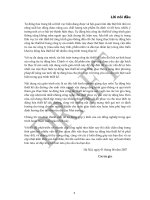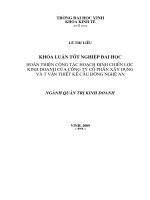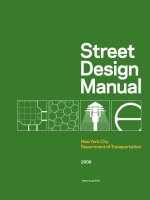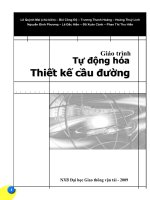thiết kế cầu đường LRFD bridge design
Bạn đang xem bản rút gọn của tài liệu. Xem và tải ngay bản đầy đủ của tài liệu tại đây (1.17 MB, 108 trang )
LRFD Bridge Design
AASHTO LRFD Bridge Design
Specifications
Loading and General Information
Created Jul
y
2007
This material is copyrighted by
The University of Cincinnati,
Dr. James A Swanson, and
Dr. Richard A Miller
It may not be reproduced, distributed, sold,
or stored by any means, electrical or
mechanical, without the expressed written
consent of The University of Cincinnati, Dr.
James A Swanson, and Dr. Richard A Miller.
July 31, 2007
LRFD Bridge Design
AASHTO LRFD Bridge Design Specification
Loads and General Information
Background and Theoretical Basis of LRFD 1
AASHTO Chapter 1 13
AASHTO Chapter 2 17
AASHTO Chapter 3 23
AASHTO Chapter 4 59
Loads Case Study 71
James A Swanson
Associate Professor
University of Cincinnati
Dept of Civil & Env. Engineering
765 Baldwin Hall
Cincinnati, OH 45221-0071
Ph: (513) 556-3774
Fx: (513) 556-2599
AASHTO LRFD Bridge Design
Specifications
James A Swanson
Richard A Miller
AASHTO-LRFD Specification, 4
th
Ed., 2007
Created July 2007
Loads & Analysis: Slide #2
AASHTO-LRFD 2007
ODOT Short Course
References
“Bridge Engineering Handbook,” Wai-Faf Chen and Lian Duan, 1999, CRC Press (0-
8493-7434-0)
“Four LRFD Design Examples of Steel Highway Bridges,” Vol. II, Chapter 1A
Highway Structures Design Handbook, Published by American Iron and Steel
Institute in cooperation with HDR Engineering, Inc. Available at /> “Design of Highway Bridges,” Richard Barker and Jay Puckett, 1977, Wiley & Sons
(0-471-30434-4)
1
Created July 2007
Loads & Analysis: Slide #3
AASHTO-LRFD 2007
ODOT Short Course
References
AASHTO Web Site: /> “Load and Resistance Factor Design for Highway Bridges,” Participant Notebook,
Available from the AASHTO web site.
Created July 2007
Loads & Analysis: Slide #4
AASHTO-LRFD 2007
ODOT Short Course
References
AISC / National Steel Bridge Alliance Web Site: elbridges. org/
“Steel Bridge Design Handbook”
2
Created July 2007
Loads & Analysis: Slide #5
AASHTO-LRFD 2007
ODOT Short Course
References
“AASHTO Standard Specification for Highway Bridges,” 17th Edition, 1997, 2003
“AASHTO LRFD Bridge Design Specifications,” 4
th
Edition, 2007
“AASHTO Guide Specification for Distribution of Loads for Highway Bridges”
Created July 2007
Loads & Analysis: Slide #6
AASHTO-LRFD 2007
ODOT Short Course
Philosophies of Design
ASD - Allowable Stress Design
LFD - Load Factor Design
LRFD - Load and Resistance Factor Design
3
Created July 2007
Loads & Analysis: Slide #7
AASHTO-LRFD 2007
ODOT Short Course
For Safety:
f - computed stress
F
A
- Allowable Stress
In terms of bending moment…
y
A
F
fF
F
S
≤=
1.82
y
F
M
S
≤
∑
Philosophies of Design
ASD: Allowable Stress Design
ASD does not recognize different variabilities of different load types.
Chen & Duan
Created July 2007
Loads & Analysis: Slide #8
AASHTO-LRFD 2007
ODOT Short Course
Philosophies of Design
LFD: Load Factor Design
For Safety:
Q - Load Effect
R - Component Resistance
γ - Load Factor
In terms of bending moment…
φ - Strength Reduction Factor
n
QR
γ
≤
∑
()
1.30 2.17
DLIn
M
MM
φ
+
+≤
In LFD, load and resistance are not considered simultaneously.
Chen & Duan
4
Created July 2007
Loads & Analysis: Slide #9
AASHTO-LRFD 2007
ODOT Short Course
For Safety:
Q - Load Effect
R - Component Resistance
γ - Load Factor
φ - Resistance Factor
Philosophies of Design
LRFD: Load & Resistance Factor Design
n
QR
γ
φ
≤
∑
The LRFD philosophy provides a more uniform,
systematic, and rational approach to the selection
of load factors and resistance factors than LFD.
Chen & Duan
Created July 2007
Loads & Analysis: Slide #10
AASHTO-LRFD 2007
ODOT Short Course
Philosophies of Design - LRFD Fundamentals
Variability of Loads and Resistances:
Suppose that we measure the weight of 100 students…
180
190
200
210
220
230
240
250
260
270
280
Weight
11
8
9
8
7
5
3
2
2
0
1
Number of
Samples
0
0
1
0
2
3
5
6
8
9
10
70
80
90
100
110
120
130
140
150
160
170
Number of
SamplesWeight
Average = 180
lbs
St Deviation = 38
lbs
5
Created July 2007
Loads & Analysis: Slide #11
AASHTO-LRFD 2007
ODOT Short Course
Philosophies of Design - LRFD Fundamentals
Variability of Loads and Resistances:
Created July 2007
Loads & Analysis: Slide #12
AASHTO-LRFD 2007
ODOT Short Course
Philosophies of Design - LRFD Fundamentals
Variability of Loads and Resistances:
Now suppose that we measure the strength of 100 ropes…
320
330
340
350
360
370
380
390
400
410
420
Weight
15
14
11
8
5
3
2
0
1
0
0
Number of
Samples
0
0
0
0
1
1
3
5
7
11
13
210
220
230
240
250
260
270
280
290
300
310
Number of
SamplesWeight
Average = 320
lbs
St Deviation = 28
lbs
6
Created July 2007
Loads & Analysis: Slide #13
AASHTO-LRFD 2007
ODOT Short Course
Philosophies of Design - LRFD Fundamentals
Variability of Loads and Resistances:
Number of Occurrences
Strength
310 360350340320 330 390380370260 270 280 290 300230 240 250 410400
1
2
10
6
5
4
3
9
8
7
220
420
11
12
13
14
15
Created July 2007
Loads & Analysis: Slide #14
AASHTO-LRFD 2007
ODOT Short Course
Philosophies of Design - LRFD Fundamentals
Variability of Loads and Resistances:
Number of Occurrences
7
Created July 2007
Loads & Analysis: Slide #15
AASHTO-LRFD 2007
ODOT Short Course
Philosophies of Design - LRFD Fundamentals
Variability of Loads and Resistances:
22
()RQ R Q
σ
σσ
−
=+
()
()
Mean
R
Q
RQ
β
σ
−
−
=
Created July 2007
Loads & Analysis: Slide #16
AASHTO-LRFD 2007
ODOT Short Course
Philosophies of Design - LRFD Fundamentals
Reliability Index:
15.9%
2.28%
0.135%
0.0233%
1.0
2.0
3.0
3.5
P(Failure)
β
8
Created July 2007
Loads & Analysis: Slide #17
AASHTO-LRFD 2007
ODOT Short Course
AISC:
AASHTO:
4.54.54.5Connections
1.752.53.0Members
D+L+ED+L+WD+(L or S)
β
Philosophies of Design - LRFD Fundamentals
Reliability Index:
β= 3.5 Super/Sub Structures
β= 2.5 Foundations
Created July 2007
Loads & Analysis: Slide #18
AASHTO-LRFD 2007
ODOT Short Course
Philosophies of Design - LRFD Fundamentals
Reliability Index:
Chen & Duan
1801088154270
1
2
3
4
5
0
ASD / LFD Bridge Designs
Span Length (ft)
Reliability Index
1801088154270
1
2
3
4
5
0
LRFD Bridge Designs (Expected)
Span Length (ft)
Reliability Index
9
Created July 2007
Loads & Analysis: Slide #19
AASHTO-LRFD 2007
ODOT Short Course
Resistance Factor:
R
m
- Mean Value of R (from experiments)
R
n
- Nominal Value of R
β
- Reliability Index
COV(R
m
) - Coeff. of Variation of R
Philosophies of Design - LRFD Fundamentals
[]
0.55 COV( )
m
R
m
n
R
e
R
β
φ
−
=
Created July 2007
Loads & Analysis: Slide #20
AASHTO-LRFD 2007
ODOT Short Course
AASHTO-LRFD Specification
10
Created July 2007
Loads & Analysis: Slide #21
AASHTO-LRFD 2007
ODOT Short Course
AASHTO-LRFD Specification
Contents
1. Introduction
2. General Design and Location
Features
3. Loads and Load Factors
4. Structural Analysis and
Evaluation
5. Concrete Structures
6. Steel Structures
7. Aluminum Structures
8. Wood Structures
9. Decks and Deck Systems
10. Foundations
11. Abutments, Piers, and Walls
12. Buried Structures and Tunnel
Liners
13. Railings
14. Joints and Bearings
15. Index
11
12
AASHTO-LRFD
Chapter 1: Introduction
AASHTO-LRFD Specification, 4
th
, 2007
Created July 2007
Loads & Analysis: Slide #23
AASHTO-LRFD 2007
ODOT Short Course
Chapter 1 – Introduction
§1.3.2: Limit States
Service:
Deals with restrictions on stress, deformation, and crack width under regular
service conditions.
Intended to ensure that the bridge performs acceptably during its design life.
Strength:
Intended to ensure that strength and stability are provided to resist statistically
significant load combinations that a bridge will experience during its design life.
Extensive distress and structural damage may occur at strength limit state
conditions, but overall structural integrity
is expected to be maintained.
Extreme Event:
Intended to ensure structural survival of a bridge during an earthquake, vehicle
collision, ice flow, or foundation scour.
Fatigue:
Deals with restrictions on stress range under regular service conditions reflecting
the number of expected cycles.
Pg 1.4-5; Chen & Duan
13
Created July 2007
Loads & Analysis: Slide #24
AASHTO-LRFD 2007
ODOT Short Course
Chapter 1 – Introduction
§1.3.2: Limit States
ii i
QQ=ηγ
∑
γ
i
- Load Factor
Q
i
- Load Effect
η
i
- Load Modifier
When the maximum value of γ
i
is appropriate
When the minimum value of γi is appropriate
0.95
iDRI
η=ηηη≥
(1.3.2.1-1)
(1.3.2.1-2)
Pg 1.3
1
1.00
i
DRI
η= ≤
ηηη
(1.3.2.1-3)
Created July 2007
Loads & Analysis: Slide #25
AASHTO-LRFD 2007
ODOT Short Course
Chapter 1 – Introduction
§1.3.2: Limit States - Load Modifiers
Pgs. 1.5-7; Chen & Duan
Applicable only to the Strength Limit State
η
D
– Ductility Factor:
η
D
= 1.05 for nonductile members
η
D
= 1.00 for conventional designs and details complying with specifications
η
D
= 0.95 for components for which additional ductility measures have been
taken
η
R
– Redundancy Factor:
η
R
= 1.05 for nonredundant members
η
R
= 1.00 for conventional levels of redundancy
η
R
= 0.95 for exceptional levels of redundancy
η
I
– Operational Importance:
η
I
= 1.05 for important bridges
η
I
= 1.00 for typical bridges
η
I
= 0.95 for relatively less important bridges
These modifiers are applied at the element level, not the entire structure.
14
Created July 2007
Loads & Analysis: Slide #26
AASHTO-LRFD 2007
ODOT Short Course
§ 3.4 - Load Factors and Combinations
§1.3.2: ODOT Recommended Load Modifiers
For the Strength Limit States
η
D
– Ductility Factor:
Use a ductility load modifier of η
D
= 1.00 for all strength limit states
η
R
– Redundancy Factor:
Use η
R
= 1.05 for “non-redundant” members
Use η
R
= 1.00 for “redundant” members
Bridges with 3 or fewer girders should be considered “non-redundant.”
Bridges with 4 girders with a spacing of 12’ or more should be considered “non-
redundant.”
Bridges with 4 girders with a spacing of less than 12’ should be considered
“redundant.”
Bridge with 5 or more girders should be considered “redundant.”
Created July 2007
Loads & Analysis: Slide #27
AASHTO-LRFD 2007
ODOT Short Course
§ 3.4 - Load Factors and Combinations
§1.3.2: ODOT Recommended Load Modifiers
For the Strength Limit States
η
R
– Redundancy Factor:
Use η
R
= 1.05 for “non-redundant” members
Use η
R
= 1.00 for “redundant” members
Single and two column piers should be considered non-redundant.
Cap and column piers with three or more columns should be considered
redundant.
T-type piers with a stem height to width ratio of 3-1 or greater should be
considered non-redundant.
For information on other substructure types, refer to NCHRP Report 458
Redundancy in Highway Bridge Substructures.
η
R
does NOT apply to foundations. Foundation redundancy is included in the
resistance factor.
15
Created July 2007
Loads & Analysis: Slide #28
AASHTO-LRFD 2007
ODOT Short Course
§ 3.4 - Load Factors and Combinations
§1.3.2: ODOT Recommended Load Modifiers
For the Strength Limit States
η
I
– Operational Importance:
In General, use η
I
= 1.00 unless one of the following applies
Use η
I
= 1.05 if any of the following apply
Design ADT ≥ 60,000
Detour length ≥ 50 miles
Any span length ≥ 500’
Use η
I
= 0.95 if both of the following apply
Design ADT ≤ 400
Detour length ≤ 10 miles
Detour length applies to the shortest, emergency detour route.
16
AASHTO-LRFD
Chapter 2: General Design and
Location Features
AASHTO-LRFD Specification, 4
th
Ed., 2007
Created July 2007
Loads & Analysis: Slide #30
AASHTO-LRFD 2007
ODOT Short Course
Chapter 2 – General Design and Location Features
Contents
2.1 – Scope
2.2 – Definitions
2.3 – Location Features
2.3.1 – Route Location
2.3.2 – Bridge Site Arrangement
2.3.3 – Clearances
2.3.4 – Environment
2.4 – Foundation Investigation
2.4.1 – General
2.4.2 – Topographic Studies
17
Created July 2007
Loads & Analysis: Slide #31
AASHTO-LRFD 2007
ODOT Short Course
Chapter 2 – General Design and Location Features
Contents
2.5 – Design Objectives
2.5.1 – Safety
2.5.2 – Serviceability
2.5.3 – Constructability
2.5.4 – Economy
2.5.5 – Bridge Aesthetics
2.6 – Hydrology and Hydraulics
2.6.1 – General
2.6.2 – Site Data
2.6.3 – Hydrologic Analysis
2.6.4 – Hydraulic Analysis
2.6.5 – Culvert Location and Waterway Area
2.6.6 – Roadway Drainage
Created July 2007
Loads & Analysis: Slide #32
AASHTO-LRFD 2007
ODOT Short Course
§ 2.5.2 - Serviceability
§2.5.2.6.2 Criteria for Deflection
ODOT requires the use of Article 2.5.2.6.2 and 2.5.2.6.3 for limiting
deflections of structures.
ODOT prohibits the use of “the stiffness contribution of railings,
sidewalks and median barriers in the design of the composite
section.”
18
Created July 2007
Loads & Analysis: Slide #33
AASHTO-LRFD 2007
ODOT Short Course
§ 2.5.2 - Serviceability
§2.5.2.6.2 Criteria for Deflection
Principles which apply
When investigating absolute deflection, load all lanes and assume all
components deflect equally.
When investigating relative deflection, choose the number and position
of loaded lanes to maximize the effect.
The live load portion of Load Combination Service I (plus impact) should
be used.
The live load is taken from Article 3.6.1.1.2 (covered later).
For skewed bridges, a right cross-section may be used, for curved
bridges, a radial cross section may be used.
ODOT prohibits the use of “the stiffness contribution of railings,
sidewalks and median barriers in the design of the composite section.”
Pg 2.10-14
Created July 2007
Loads & Analysis: Slide #34
AASHTO-LRFD 2007
ODOT Short Course
§ 2.5.2 - Serviceability
§2.5.2.6.2 Criteria for Deflection
Span/375Vehicular and/or pedestrian load on
cantilever arms
Span/300Vehicular load on cantilever arms
Span/1000Vehicular and/or pedestrian load
Span/800General vehicular load
LimitLoad
In the absence of other criteria, these limits may be applied to
steel, aluminum and/or concrete bridges:
For steel I girders/beams, the provisions of Arts. 6.10.4.2 and 6.11.4 regarding
control of deflection through flange stress controls shall apply.
Pg 2.10-14
19









